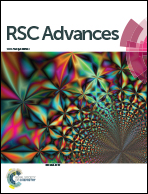Durable antifouling polyvinylidene fluoride membrane via surface zwitterionicalization mediated by an amphiphilic copolymer†
Abstract
The antifouling properties of a polyvinylidene fluoride (PVDF) membrane were remarkably enhanced by facile incorporation of an amphiphilic triblock copolymer poly(N,N-dimethylamino-2-ethylmethacrylate)-b-polydimethylsiloxane-b-poly(N,N-dimethylamino-2-ethylmethacrylate) (PDMAEMA-b-PDMS-b-PDMAEMA) synthesized via the atom transfer radical polymerization and subsequent surface zwitterionicalization, which provided a stable fouling-resistance interface to avoid undesirable “hydrophobic recovery”. As compared with the pure PVDF membrane, the total flux decline ratio of protein pollution parameters is substantially reduced as low as 14.5% and the BSA rejection of the blend membranes is increased from 33% to 90%, which proves the decrease of effective membrane pore size. The dramatic performance enhancement is attributed to the formation of unique rod-like micelles on the zwitterionic membrane surface due to the self-assembly of the amphiphilic polymer during quaternization. The spontaneous migration of PDMAEMA segments to the membrane surface as conformed by XPS measurement results in significant improvement of the wetting properties, and in situ quaternization further expands the migration rate. The continual migration of the internal amphiphilic copolymers can form a renewable surface to ensure excellent antifouling and durability as conformed by the time-dependent flux test for 30 days. Furthermore, the elastic hydrophobic segments PDMS act as anchors in the matrix, which effectively prevent the elution of amphiphilic polymer. This one-step approach to achieve surface zwitterionicalization is promising to provide a simple strategy for the preparation of multifunctional zwitterionic polymers on the surface of polymeric membrane materials to meet with various demands for further applications, i.e. antifouling and antibacterial properties, etc.


 Please wait while we load your content...
Please wait while we load your content...